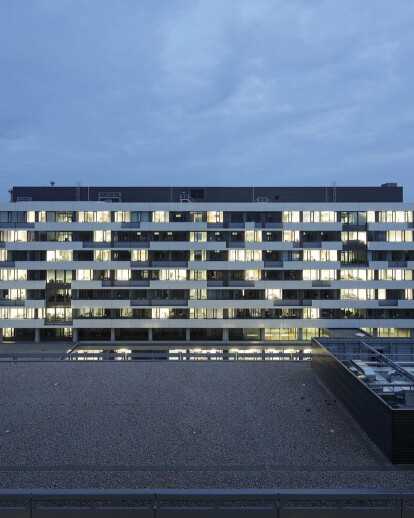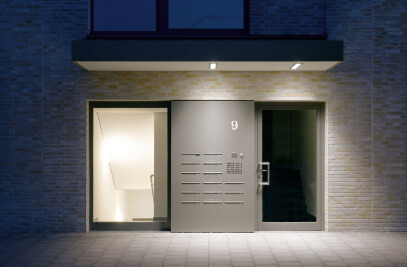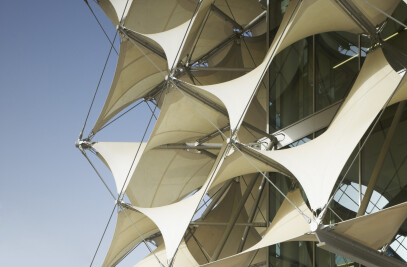The Ruhr-Universität Bochum’s IC-Complex has undergone a two-year process of refurbishment, and is now a state-of-the-art research building. This complex of buildings now provides a space where around 5,000 students and scientists can study and research in a harmonious architectural environment that is technologically equipped to a high standard, and is ideally suited to its function.
The Ruhr-Universität Bochum first opened in 1965. Taken as a whole, the university complex is divided into four sections, serving medical sciences, the physical sciences, the humanities, and engineering sciences respectively. The thirteen institute buildings are all constructed based on a single uniform grid, whilst a north-south central spine and an east-west greened spine route provide access. The I-Complex, which houses the engineering sciences, is located in the north-eastern part of the campus. Sections of this I-Complex are being refurbished and made ready for occupation by HOCHTIEF, based upon plans made by Gerber Architekten. HOCHTIEF carried out a two-year pollutant clearance and core refurbishment of the First Section, which is already in use by the Ruhr- Universität Bochum as a state-of-the-art research building.
The new clear and linear route network for the whole of the engineering complex provides simplified access to all institute areas. Visual connections with the newlyconfigured inner courtyards and communications between the storeys enhance the quality of the spaces and allow people to find their way intuitively within the buildings, and also in the outdoor spaces. Under a negotiated procedure, Gerber Architekten (via HOCHTIEF) are currently engaged in planning new replacement buildings for the additional building sections IA and IB, and in constructing a new centre for interface-dominated high performance materials, which has been given a sculptural form in order to create a contrast with the more regular buildings surrounding it.
Urban planning concept Construction of the Ruhr-Universität Bochum began in 1965, and concluded in 1970. The university’s buildings are quite distinctive owing to their clear structure; the unified appearance and functionality of this architectural structure reflects the architectural ideology of their era of construction. The design created by the architecture firm HPP includes a total of 13 institute buildings belonging to the faculties of medical sciences, the physical sciences, the humanities and engineering sciences. They are built on a uniform grid, with the interdisciplinary and administrative areas located in the centre of the university complex.
The “I-Row“, which is used by the engineering sciences faculty, is located on the northeastern edge of the university site. The IC complex, which has been refurbished by Gerber Architekten, is a part of this row of buildings. It consists of two three-storey low-rise buildings (the ICFW and ICFO buildings) plus the IC high-rise block, which straddles them. In urban planning terms, the aim pursued by Gerber Architekten was to remedy the lack of an internal access system for the whole of the complex (which had been identified as a functional weakness), and to make it easier for people to find their way. For the IC complex, two new pedestrian spines were created: the north-south main route through the IC high-rise building and the east-west main route, which interconnects the whole of the engineering complex, running from IA to ID.
There is now an additional new main entrance on the north side which is linked to the existing entrance via the north-south main route. The visitor passes through the new north entrance and traverses a dramatic cascading open stair to reach the existing south entrance located two levels higher up. The inclusion of visual connections with the library – which is the heart of the building – and with the green inner courtyard enhances the spatial quality of this pedestrian spine.
The east-west main route begins at the existing southern entrance of the high-rise building. It provides access to the interior, leading to the new ID building in one direction, and the IA high-rise block in the other. The new three-storey open staircases were added in the form of gallery-type glazed superimposed structures located within the courtyards. This ensures that every level of the various building sections can be reached using the main route – in spite of their differing heights. The gallery levels are intended for use as zones of communication. They are made additionally attractive as places for people to linger by the open voids, and by the direct view they command of the three inner courtyards. The inner courtyards were reconstructed by the landscape architects Georg and Rosemarie Penker, based upon the original designs. The existing materials were extensively upgraded, and were partially replaced.
Architectural concept The Ruhr-Universität Bochum’s complex of buildings was built to satisfy a need for functional high-rise university buildings that existed in the 1970s. This complex, however, is ill-equipped for the demands of research and learning today. The existing architectural resources, nevertheless, are worth preserving for the sake of sustainability. A decision was therefore taken to refurbish the whole complex.
Critically, Gerber Architekten’s design for the I-Complex takes into account the typology of the existing buildings. It retains the same overall building volume, and also retains the same functional building structure, with the addition of a new interior space and façade concept. Additionally, the whole of the complex was given a barrier-free layout. There are two auditoria, each of which can seat 340, plus 57 laboratories and numerous seminar and office buildings. These facilities allow around 5,000 students and scientists to study and to conduct research in an environment that is technologically equipped to a high standard, and is ideally suited to its function.
Within the building, there is a clear spatial separation between the two faculties – the faculty of mechanical engineering and the faculty of civil and environmental engineering. The mechanical engineering areas are largely located within the eastern low-rise structures and within the three lower levels of the high-rise structure; the civil and environmental engineering sciences rooms, on the other hand, extend into the western low-rise building and into the three upper levels of the high-rise building. The central areas – the library, the CIP stations, the faculty offices, the dean’s offices and the administration offices – are located in the core areas of the low-rise buildings, beneath the high-rise building. The interdisciplinary and heavily-frequented areas are arranged so as to adjoin the north-south main route directly. The seminar rooms and the two auditoria are used by all faculties, and are located in the southerly areas of the lowrise buildings. The new ICAMS institute is also located in this readily accessible area, and is self-evidently an autonomous “building block” in the architectural structure of the ICComplex.
The floor plans for the high-rise building’s standard storeys have a classic three-part structure, with offices and seminar rooms located in the outer area and with a supply and access structure plus enclosed discussion areas in the central zone. This arrangement allows all the permanent workspaces to be naturally lit and ventilated. The student workspaces are also located in the regular storeys, with a view of the inner courtyard and of the location’s green surroundings. Gerber Architekten wanted special student workspaces for these zones that would be pleasant, and would also offer good potential for communication and exchange in between learning events. The levels located along the main route’s staircase are laid out following the idea of a marketplace. They are a place where the people who work together every day in the ICComplex can meet up, spend time and communicate.
Laboratory planning Modern state-of-the-art laboratories should be flexible, adaptable and efficient in their use of space, to enable them to accommodate the specific practical demands associated with the various different disciplines. Owing to the heterogeneous nature of research in these fields, the technological faculties (mechanical engineering and civil and environmental sciences) require individual laboratories where the ambient conditions and the media interfaces can be individually adjusted for large items of equipment. The pre-existing spatial structure of the IC complex’s low-rise buildings offered the ideal preconditions for implementing laboratories geared for optimal utility. For the most part, it was possible to retain the sizes of the laboratories as they existed within the original grid. This made it possible to offer an individual use structure, without sacrificing the flexibility required for future use and conversion.
Construction and pollutants The IC-building, like the Ruhr-Universität as a whole, is characterized by the industrial building methods of the 1960s. The existing structure is based upon a 7.5m on 7.5m support grid. Owing to the building’s considerable depth of 22.5 m, its spaces were given a three-part organisational structure. This geometric system and the subdivided nature of the façade structure permit a high degree of flexibility in the floor plan, meaning that the institute building can be easily adapted at any future time through the use of light separating walls, in response to changing demands associated with research. The typology of the IC-building was left unchanged. Listed building requirements were respected, in order to preserve the silhouette and the architectural character of the complex as a whole. As the building is not officially a protected structure, the sevenpoint- plan drawn up specifically for the Ruhr-Universität was used. The existing building was stripped back to the bare shell by HOCHTIEF. All damaged components were removed, along with pollutant substances such as asbestos and PCBs. In the course of its being renovated and made ready for handing over, the structure was improved in terms of energy usage and ecological issues. Additionally, the whole of the building was redesigned to ensure sustainability. Professor Eckhard Gerber describes the intentions behind his design thus: “The things that we build will still meet the required needs in 50 years. The less things have to be changed in the future, the more affordable and sustainable the buildings are. Additionally, it is more agreeable to us as architects if our project can be allowed to remain as we planned it.”
Façade concept The visual appearance of the IC high-rise building’s old façade was characterized by bands of glazing, and by continuous emergency exit balconies on all sides. The balconies were no longer required for fire safety purposes following the renovation. In spite of this, Gerber Architekten decided to create new balconies as part of the renovation, in compliance with the seven-point plan for historic monument conservation. On the one hand, these balconies assist in protecting the office spaces from the sun and, on the other hand, they enable the façade to be cleaned without extensive use of technology. The new façade elements and balconies fit into the overall visual profile, and also give the building a new identity. They are composed of a lightweight steel construction. The balustrades are partially left open and are partially constructed from sheet aluminium cladding. These newly constructed balconies for the high-rise section and the horizontal strip structure and vertical support claddings, which echo the loadbearing structure’s 7.5m grid, are sensitive to the urban planning context of the area and conform to preservationrelated concerns.
The design aims to relieve the otherwise severe design of the façades by including a three-storey area on each of the long sides of the building. These areas are offset in relation to one another. On the one hand, this arrangement provides the widest possible views of the RUB’s green surroundings, and, on the other hand, the break between the two areas in terms of design makes the institute’s internal separation visible to people on the outside of the building. The student workspaces are located in the high-quality spaces offered by these communication zones. The glass stairwells arranged along the east-west main route are integrated into the building in an additive fashion. This allowed the required width for the access routes to be achieved, without any interventions having to be made in the building’s existing loadbearing structural system. In order to minimise the impact of the sun and of solar gain in these new passageways and stair areas, the roof surfaces adjoining the courtyards were closed in, using solid components. The new façades conform to the most up-to-date energy standards and ecological standards, and also have an appealing visual design.
Continuation Through HOCHTIEF, Gerber Architekten have also been engaged to plan the IA and IB building sections. In addition, Gerber Architekten are currently planning a new building which will be situated between these two high-rise buildings: a new centre for interface dominated high performance materials. It will be a four-storey stand-alone building, with a sculptural form to set it apart from the more regular buildings surrounding it.
Background In the 1960s, a plan became established to create a technical university in the Ruhrgebiet region. This “university campus in a green space” was to be built at Bochum. The construction of the Ruhr-Universität commenced in January 1964, and the first institute building was first occupied in 1965. The plan was created by the architectural firm HPP; the structure of all university buildings was based on a uniform dimensioning grid. Prefabricated concrete parts were used, ensuring a rapid and low-cost building process. This material gave the architecture a rough and functional quality that was in line with the ideas of the era, but was unpopular with students and professors even at the time of its building. In addition to this, damage to the infrastructure was discovered as early as 1974. Signs of erosion, deposits and discoloration on surfaces – accompanied by cracks, rust stains, spalling breakages in the concrete, and corrosion – led to the whole campus requiring renovations in whole and in part, as well as the removal of pollutants (beginning in 2008). At the same time, thought was given to the changed needs in terms of research, learning and building function in order to ensure that the Ruhr-Universität continues to retain its position as a technologically sophisticated centre of scientific knowledge.

































